Assembling the Ultimate Mini PC (2017)
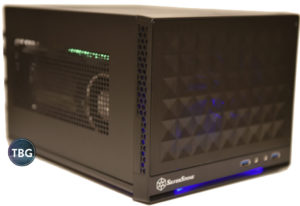
Introduction
We embarked upon this article with one goal in mind: to build the sweetest ITX system possible. Truth be told, it’s not our first attempt, and we know what it looks like to miss the mark. Back in 2014, The Tech Buyer’s Guru brought you “Project ITX,” which we somewhat humorously dubbed the “Smallest, Fastest, Quietest PC Ever!” Of course, that was really meant to be tongue-in-cheek, as you can’t have all three, but you can certainly give it your best try! And while Project ITX was small, fast, and quiet, it wasn’t without its problems, the most significant of which were serious fitment issues with standard off-the-shelf parts. Well, nearly three years have gone by, and we decided that we’d give it another go.
The main cause of concern in Project ITX was in fact the SilverStone SG08-Lite case, which suffered from significant design flaws that made building a high-performance gaming system in it nearly impossible. We were very honest at that time regarding our concerns, and we went straight to SilverStone to tell them how concerned we were with a case that we believed was basically out of spec. Luckily, SilverStone took it all in stride and they were all too happy to provide a few pieces of choice gear for our second go-round at building the Ultimate Mini PC. No, it’s not Project ITX, because this time it’s not a project, it’s a fully-vetted solution! We’re going to show you exactly how to build your own massively-capable, incredibly-compact, and yes, very quiet gaming PC.
By the way, we want to address one concern we have about the ITX case market over the past few years. Many of our readers have come to us asking about unique cases offered on Kickstarter, like the NCase M1 or the Dan Cases A4. Here’s our take on these imaginative, custom-made products: they’re absurdly expensive and uniquely full of pitfalls. Yes, we’ve seen the flashy marketing material, and it all looks super-cool. But because we’ve been hands-on with more than a few ITX cases, we know that throwing together a Photoshopped promo image to generate seed funding and building a workable ITX case are not one and the same. Folks, we strongly recommend you stay away from these cases unless you simply want to make a donation to these small companies because you like their grit and determination. Don’t do it because they promise you the world (i.e., the smallest, fastest, quietest PC ever…)
With that being said, here are the very much off-the-shelf parts we used for this build:
- CPU: Intel Core i7-7700K
- Motherboard: Asus Z170I Pro Gaming (current version is Asus Z270I ROG Strix)
- Video Card: Nvidia Titan X Pascal 12GB
- SSD #1: Samsung 850 Evo 500GB
- SSD #2: Toshiba OCZ Trion 150 960GB
- RAM: Corsair Vengeance 2x8GB DDR4-3000
- Case: SilverStone Sugo SG13 (thank you to SilverStone for providing this review sample)
- CPU Cooler: SilverStone NT06-Pro (thank you to SilverStone for providing this review sample)
- CPU Fan Low-Noise Adapter: Noctua NA-SRC7 (thank you to Noctua for providing this review sample)
- Thermal Paste: Noctua NT-H1 (thank you to Noctua for providing this review sample)
- Case Fan: Arctic F12 PWM 120mm (thank you to Arctic for providing this review sample)
- Power Supply: SilverStone Strider SX700-LPT (thank you to SilverStone for providing this review sample)
- Power Supply Bracket: SilverStone RL-PP08B ATX to SFX (thank you to SilverStone for providing this review sample)
- Operating System: Windows 10 Flash Drive
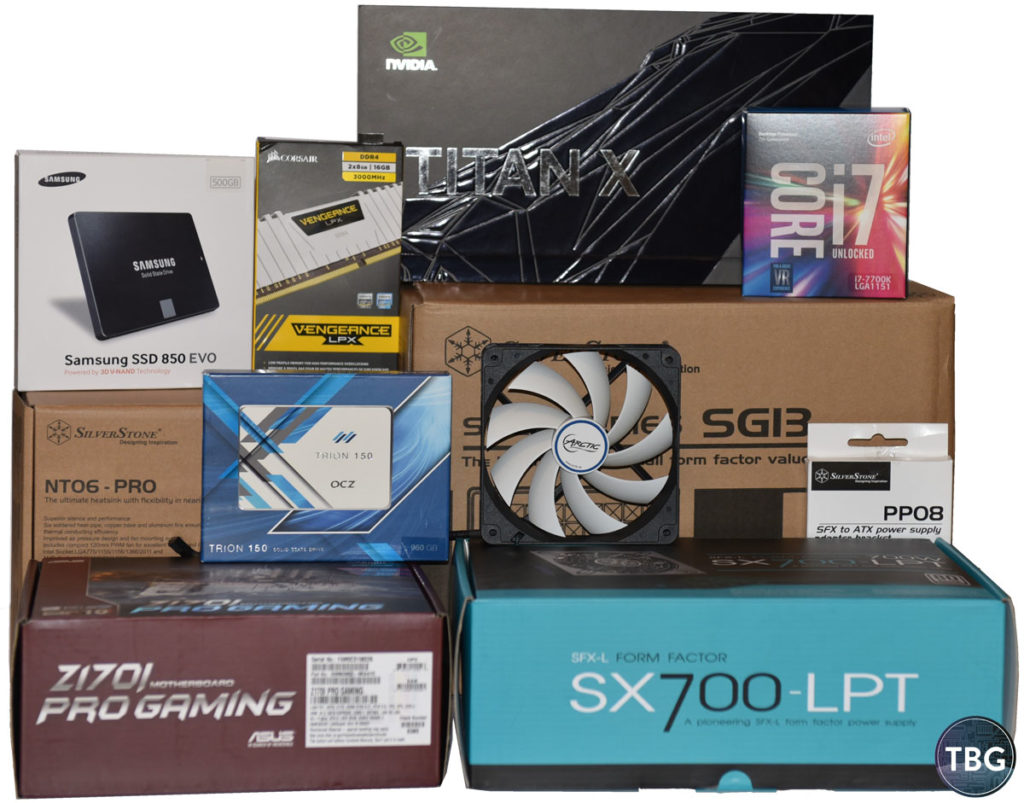
All told, the retail value of these components was just over $2,600 at the time of publication. As built, this system is most similar to the configuration currently listed in our $1,500 VR-Ready Mini-ITX PC Buyer’s Guide, but with a Titan X Pascal substituted for a GeForce GTX 1070, along with an upgraded cooler and power supply.
It’s important to note that in our Do-It-Yourself Buyer’s Guides, we always take a few steps back from the most extreme options, because we won’t risk our readers encountering an unexpected clearance issue or cooling limitation. When we want to recommend something really over the top, we build it ourselves first. That’s the lesson we learned with our Project ITX, which in the end turned out to be something that didn’t quite meet our standards for recommending to our readers. As you’ll see, we came within a razor thin margin of meeting the same fate with the Ultimate Mini PC, but thankfully, this time it’s something we will recommend to our most intrepid readers!
OK, with that out of the way, let’s move on to the building process!
Installing the CPU Cooler
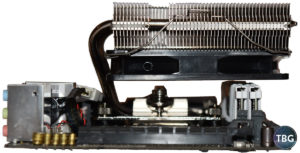
On this page, we’re going to cover all the areas that are unique to building this highly-customized ITX system, starting with the CPU cooler. As you’re going to learn again and again as we step through the assembly of this system, there’s not a lot of clearance to spare. But that’s the fun of it, right – seeing how much we can cram into a tiny PC case? Well, hold on a second there, partner. The goal is actually to see how balanced a system we can cram into a tiny PC case, and how repeatable the process is for others who’d like to do the same. When you’re done reading this article, we promise that you too can go out and buy these parts and build this system yourself! The only caveat: we aren’t going to be covering basics like mounting a CPU, connecting cables, or installing RAM. If you’d like help on these items, check out our detailed High-End PC Assembly Guide (2017).
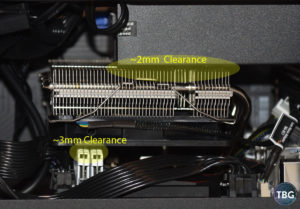
We previously reviewed the SilverStone NT06-Pro cooler, and while its performance was exceptional for a low-profile model, it had two drawbacks: it’s nearly impossible to install if a motherboard is already in a chassis, and its fan is simply too loud. We were able to address both issues for purposes of this build. First things first: there’s no way you can install this cooler while the motherboard is in the SG13 case, because you don’t have access to the rear of the motherboard, so you’re just going to have to follow instructions! Luckily, the cooler is really pretty easy to install when it’s outside of a case. The only catch for this system is that you actually have to know which way to orient it; while you can point it in one of four directions, only one is going to work! We’ve detailed that in the photo here. Note that the spacing on our board (the Asus Z170I) and the updated model (the Asus Z270I) is identical, so this will work with either board. In short, the heatpipes must face the back of the case, and the cooler must overhang the right side of the board.
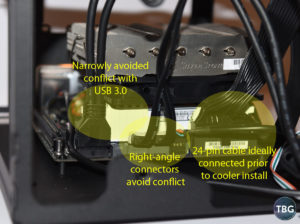
This of course causes another potential headache: access to cable headers. In particular, on some boards, you may lose access to the USB 3.0 header (the layout of the Asus ITX narrowly made the cut in this regard), and you’ll also have a heck of a time plugging in the 24-pin motherboard cable with the cooler in place. You may want to install it before you install the cooler, taking advantage of the fact that the power supply is fully modular (in other words, you don’t need the PSU hanging off your board the entire time). One last tip: use right-angle SATA connectors, as straight cables will run right into the cooler’s fan perched above the ports.
With regard to the noisy fan spec’d on the NT06-Pro, we learned that we couldn’t in fact replace it outright, because it’s slim design was crucial for providing sufficient clearance for our low-profile Corsair Vengeance LPX RAM. Yes, we tried, and no, it didn’t come close to working (the NT06-Pro’s fan is 20mm thick, versus the standard 25mm thickness, and we only had about 3mm to spare above our RAM sticks). So we did the next best thing with regard to noise: we tamed the fan. Noctua’s handy NA-SRC7 low-noise adapters cut voltage to fans, thereby reducing their RPMs. Due to the way voltage reduction affects motor operation, it happens to take more off the top (i.e. the maximum) then it does the low end, which is sort of a shame, but at least it made idle noise tolerable by dropping minimum rotational speed from well over 1200RPM to 1050RPM.
Installing the Case Fan
In the interest of “consumer choice,” SilverStone refrained from including any active cooling in this case. But for a system like the one we’re building, that should not be taken as a sign that the case doesn’t need active cooling. So the first item on the agenda after picking our CPU cooler (and getting it to fit!) was to mount a front fan in the case.
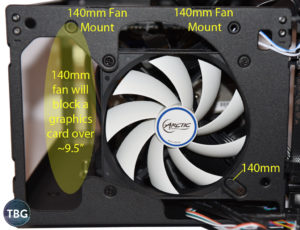
We chose the excellent Arctic F12 PWM fan, one of the lowest-cost fans on the market to include both fluid dynamic bearings and a PWM function. We also happen to like the white blades, a hint of which can be seen through the front panel’s mesh when spinning. Note that although the SG13 can theoretically accept both 120mm and 140mm fans, as we detail in the photo to the left, installing a 140mm fan will mean you can’t use video cards longer than around 9.5″ (SilverStone’s specs indicate the limit is in fact 9.3″). In other words, you’re going to need a compact card if you want a 140mm fan, but that means you’re either going with a lower-powered card, or you’re using a compact version of a high-powered card, which is going to sacrifice enough cooling potential to offset any gains achieved by the 140mm fan. So basically, don’t bother with a 140mm fan in this case unless you’re building a home theater PC with a basic lower-end video card.
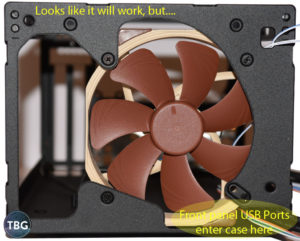
Truth be told, we actually thought we could get around this official limitation by using a 140mm fan with 120mm fan mounts, specifically the fabulous Noctua NF-A15 PWM. Turns out this was one mistake we made that you need not repeat. It simply won’t work, no matter how much you want it to! The frame of the fan blocks the housing of the front panel USB 3.0 connectors from seating within the case. In other words, you’re not going to have a front panel on your case if you try this at home!
Installing the Power Supply
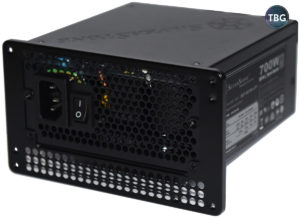
OK, this is where we had to turn to SilverStone for a bespoke solution to a vexing problem. The SG13 is designed to fit ATX power supplies, which obviously use a different mounting standard than smaller SFX-class units. And while some of SilverStone’s SFX power supplies come with adapters (notably, the SX500-LG), that bracket mounts the PSU right in the center of the vent, which wouldn’t provide enough clearance for our big CPU cooler. Luckily, SilverStone actually designed a second SFX-to-ATX adapter, the RL-PP08B, which it sells as an aftermarket component. This little gem is what allowed this entire system to come into being. Take a look at the photo below to see just how close the PSU sits to our CPU cooler. While the PSU can be mounted fan up or fan down, we chose to mount it fan down so that it would work in concert with the NT06-Pro’s CPU cooler’s fan, which blows upwards and into the PSU, at least in part. Some of the hot air will actually escape through the vent area in the offset section of the bracket, which SilverStone thoughtfully designed into the part.

By the way, if you’re a regular reader of The Tech Buyer’s Guru, you know that we review a lot of SilverStone gear, and we generally really like it. But we’ll be the first to call SilverStone out when it makes a mis-step, and SilverStone is always gracious in accepting this criticism. So here’s the brutal truth: SilverStone should never have marketed the SG13 case as compatible with ATX PSUs. We know why they did it (for System Integrators, who have factory labor struggle to build technically out-of-spec systems), but back on Planet Earth (i.e., where you, our readers, live), this case is not compatible with ATX power supplies. So we’ll just leave it at this: the SilverStone SG13, a SilverStone SFX-L power supply, and the SilverStone PP08 adapter make for a wonderful combo that pushes the limits in terms of miniaturization without crossing the line.
Installing the Video Card
The final major step is to install the video card. While you may think you’re going to be inserting the card in from the side, or perhaps the top, you’ll quickly realize that the frame of the SG13 is actually shorter than most high-performance cards. The SG13 is based on the venerable SG05, which was released at a time when video cards were shorter than they are today. So SilverStone got crafty and punched a hole right through the front of the case, allowing the card to essentially protrude beyond the confines of the case. It then designed a front panel with a cavity inside to cover the card, sort of like a cap. In the photo below, we’re in the process of inserting our Titan X Pascal through the front cutout.
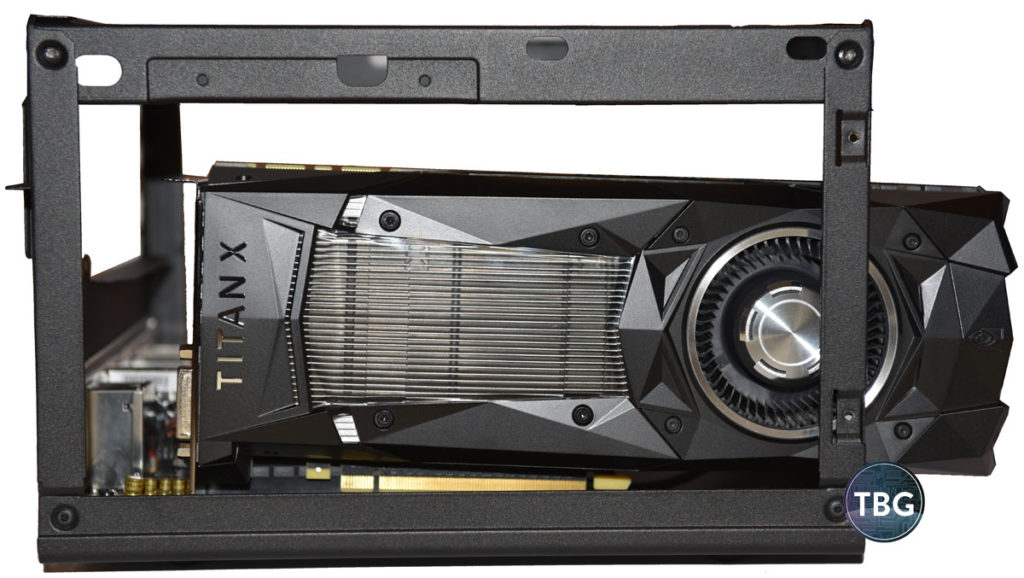
Once the video card is in place and properly cabled up, the final step is to lower the SSD tray into position. You’ll see what that looks like below.
Performance

We know the performance of this system is going to be pretty good, given that it uses the fastest quad-core CPU on the market and the fastest GPU on the market. The real question is whether it can keep up with larger systems, and thus deliver on the promise of a true ultra-high-end gaming system in a small package.
To find the answer, we decided to run it both stock and overclocked, and then compare it to a few ATX benchmarking systems we have on hand. The first is the system in our $2,500 Extreme 4K Gaming PC Buyer’s Guide, which uses a Core i7-7700K and dual GeForce GTX 1070 cards in SLI. The second is the $5,000 Ultra-Extreme Gaming PC Buyer’s Guide, running a Core i7-6900K eight-core CPU and dual GeForce GTX 1080 cards in SLI, which we ran fully-overclocked just to show the true potential of a full tower system.
In the table below, you can see how these systems compare in 3DMark Time Spy, an advanced DX12 benchmarking test.
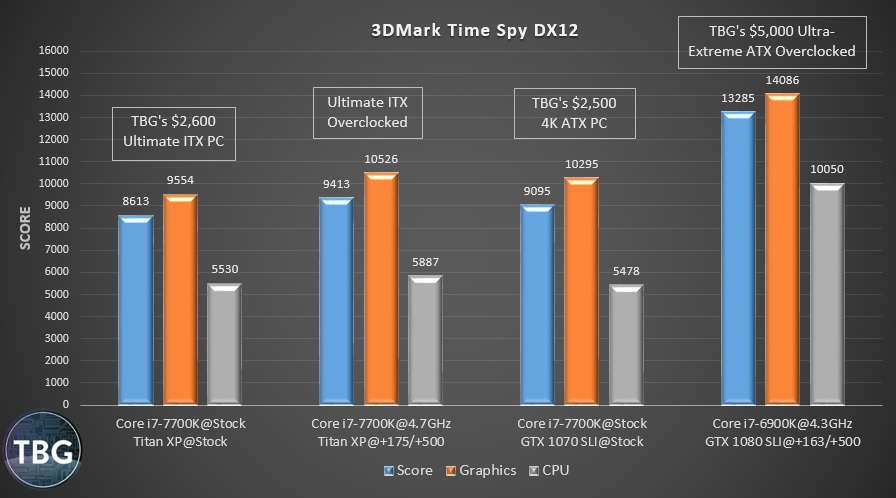
The dual GTX 1070 system just squeaks by the Ultimate Mini PC at stock settings, but falls behind once the Mini machine is overclocked. Do keep in mind, however, that the 7700K in the big tower can be overclocked as well, and that it will hit higher speeds with the big cooling possible in a big tower. Furthermore, the GTX 1070 cards can overclock just as well as the Titan, so in the end, the full-size system will be a tad bit faster. And what of the overclocked, liquid-cooled eight-core system and its dual GTX 1080 cards? Its CPU is capable of 71% more flat-out performance, at least in CPU-limited scenarios, while the video card array is 34% faster than the overclocked Titan X.
Let’s put this into perspective for a moment. The system we’ve profiled in this article is just 11.5 liters. The case we utilized for our $2,500 ATX Build is over 60 liters, and the case we utilized for our “Ultra-Extreme” system is over 70 liters. So while the ITX system does come with certain limitations, you’ve got to admit that it’s packing a whole lot of power into an insanely-small form factor. And it costs just $2,600, meaning you really aren’t paying much of a premium for fitting all that potential into a small package, thanks in part to the very reasonable price of the SilverStone case, cooler, and power supply.
Now there’s another aspect of performance that’s pretty important to a lot of users, and that’s temperature and noise data. We’ve gathered that for you below, using the Combined Test in 3DMark Fire Strike Extreme, a 4K benchmark that seriously stressed the GPU, and puts a moderate load on the CPU – a lot like modern games.
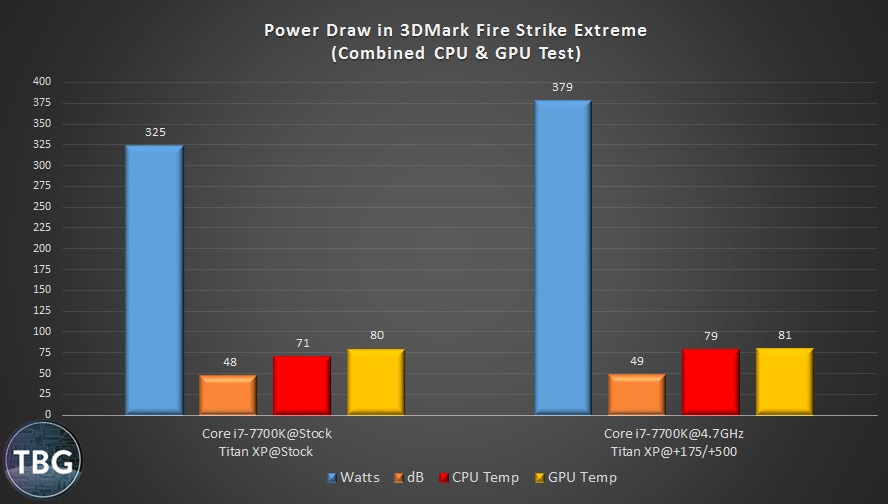
The power use of this system is really quite reasonable, but you can see that once overclocked, it could stress a less-capable power supply, especially given that the CPU is exhausting directly into the PSU intake. Luckily, the amazing SilverStone Strider 700W Platinum SFX-L unit we used has more than enough capacity and efficiency to contend with the stress and heat. With regard to noise, the system was certainly audible, with the sound of the Titan X Pascal’s radial fan dominating the noise profile. Given how much heat it generates, this is to be expected, and no, we don’t think a custom open-air cooler would work any better in this case, as the heat would be dumped directly on top of the video card, with nowhere to go. In fact, much of it would be trapped between the card and either the power supply or the SSD tray. Seriously, folks, you want that heat being pushed out of the case.
Note that while not shown in the graph, we measured idle noise to be 36 dB for both the stock and overclocked system, which is quite reasonable, if not entirely silent. Most of that had to do with the front intake fan being so close to our sound meter. In reality, accurately comparing sound measurements on a system this small is challenging; in a typical tower case, placing a sound meter at the base of the system in fact means placing it at least a foot away from any noise-generating components, but with the SG13 case, the fans are all right there, a few inches from the sound meter. So, to be clear, this is not an unusually-loud system, even if it “measures” loud versus an ATX tower.
The temperature readings we came up with were relatively impressive, especially for the GPU, which would run as hot or hotter in a full-tower ATX system. Its direct access to external cool air, both through the side vent and from the front intake fan, really helps it perform well in this little system. The CPU, on the other hand, was a bit stressed, and this is the trade-off when using a low-profile cooler that has very little breathing room, limited further by the noise reduction cable we fitted to its fan. To unleash a bit more cooling potential, we could have tested it without the noise reducer, but we felt that the balance of performance and noise we achieved with the system as built was about right. And yes, you can equip this system with a 120mm liquid cooler, which is what SilverStone recommends for high-end builders, but that too would come with trade-offs. First, it would be nearly impossible to fit the tubing in the system without risking crimping a hose or tweaking a seal, and furthermore, you’d have to either exhaust out the front, depriving the motherboard and back of the video card of any active cooling, or blow hot air into the system, which would probably be even worse. Basically, we’re just not sold on liquid cooling for a system like this, and we honestly think it’s best to just run a chip like the Core i7-7700K at stock speeds and enjoy a finely-balanced system. Getting a nice overclock on that Titan X is a whole lot more important for gaming, and the cool air provided by a 120mm intake fan helps greatly in that regard.
Final Thoughts
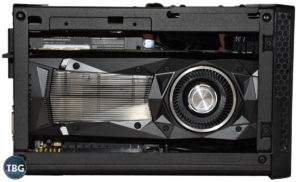
There’s a special place in our hearts, and the hearts of many of our readers, for compact yet high-powered systems. Since this site was founded in 2013, we’ve made it one of our goals to have the most comprehensive coverage of Small Form Factor systems available, and we believe that’s helped make our Mini ITX Buyer’s Guides the most popular such guides on the Internet.
To inform our coverage of the SFF market, we’ve built up a lot of ITX systems over the years, and the Ultimate Mini PC is by far our favorite. It was surprisingly easy to build (as in everything actually fit, not something to be taken for granted), it’s relatively quiet, and it’s massively powerful. And it’s just so darn small! As we hope we’ve shown in this article, there’s in fact very little it cannot do, and amazingly, you don’t need to pay a big premium to achieve big-system performance.
We hope you’ve found this guide useful… perhaps it will even inspire you to build your next PC! As always, to see our latest recommendations on PC component picks at price and in every form factor, check out our Do-It-Yourself Buyer’s Guides, updated on a monthly basis to keep you up to speed on all the latest developments.
